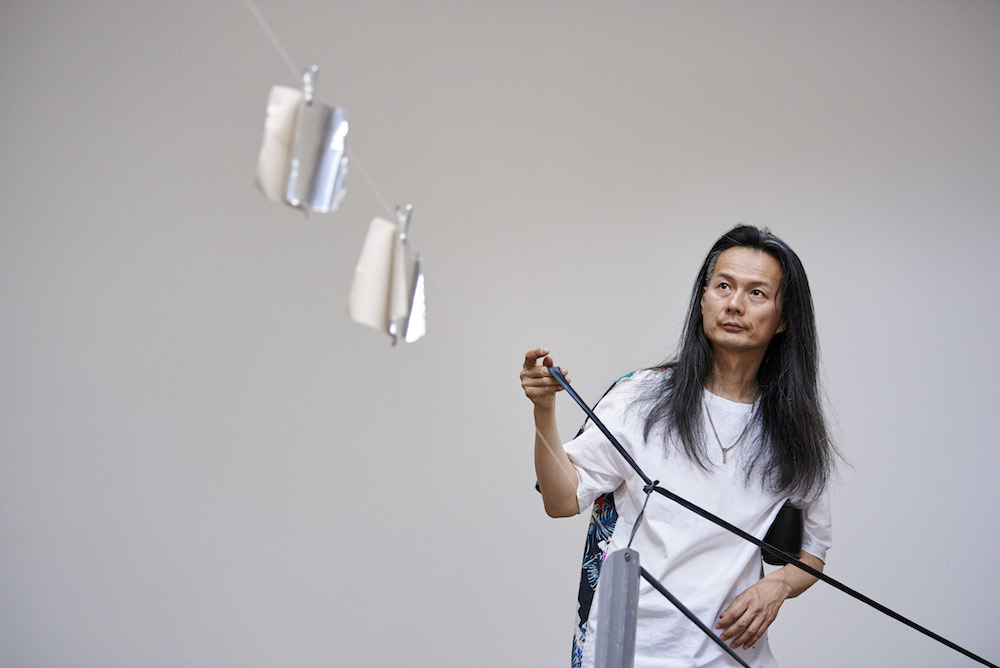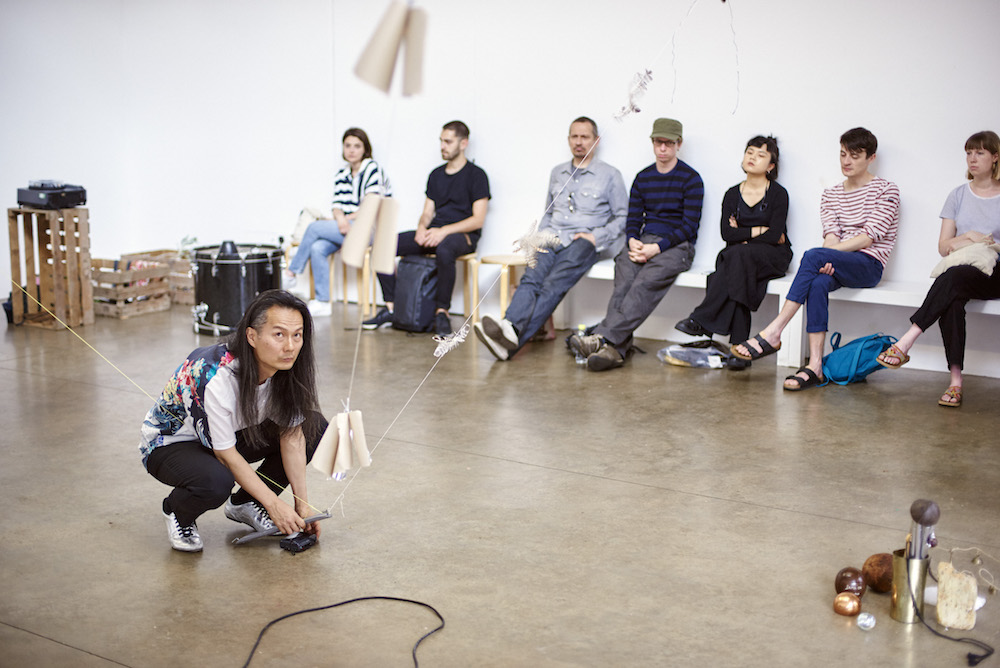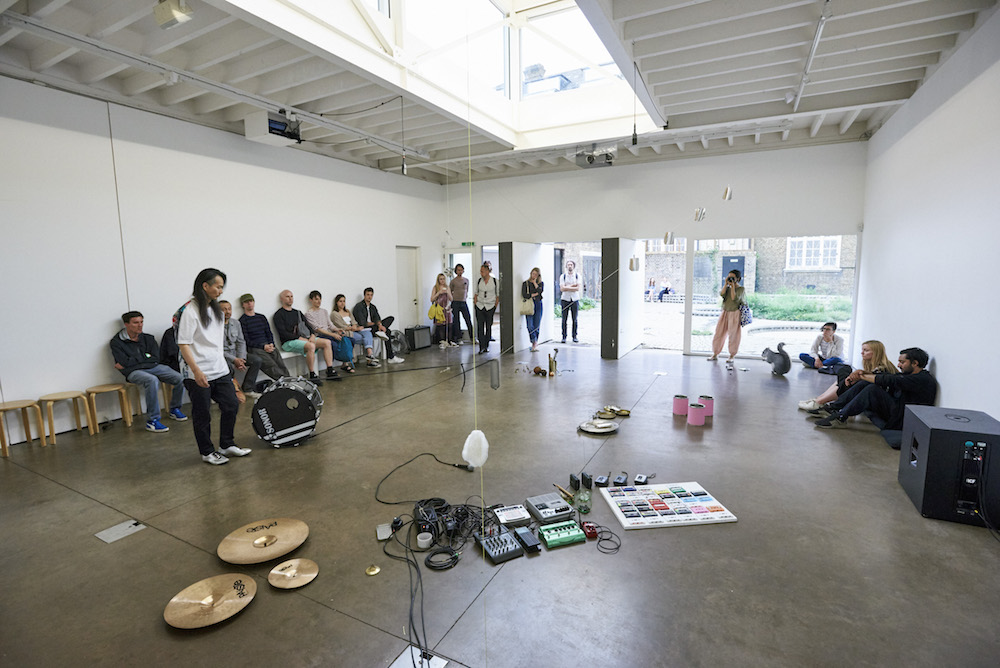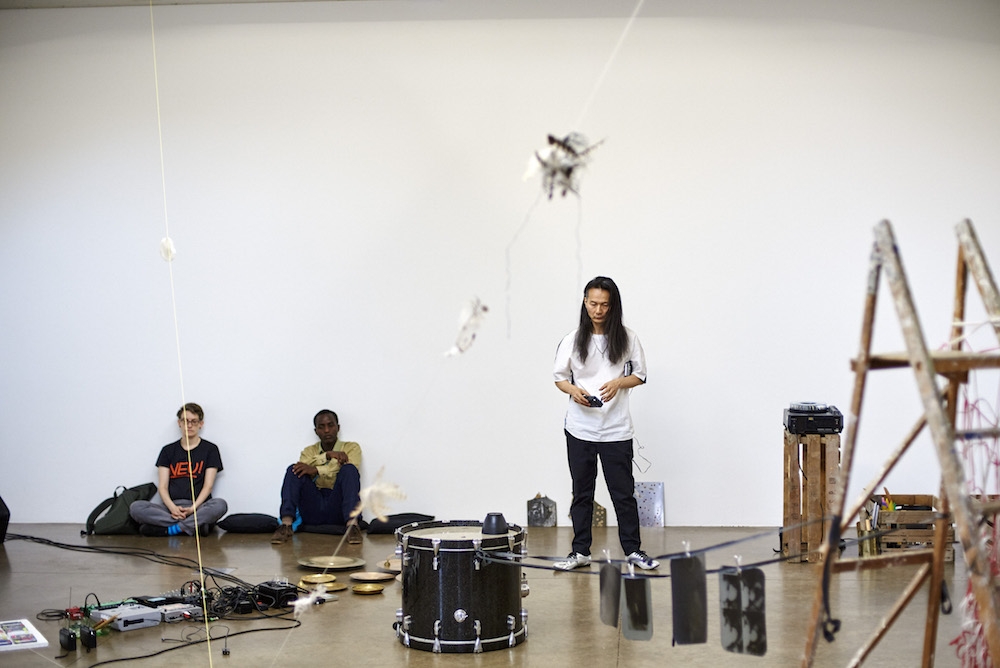South London Gallery, London, 24 June
A common sight at the start of car boot sales and flea-markets is the seller’s preliminary act of defining their pitch by placing objects at its extremities. Sometimes these boundary-marking objects are merely boxes, though more often they’re substantial yet unimportant articles: a cast-iron rooster, an inactive carriage clock, a solo candlestick. But this frontier-defining chintz is soon rendered invisible with the addition of glitzier, more saleable stuff within the newly-demarcated zone.
Were these objects affecting the flow and resonance of sound on some quantum level, on the boundary of perception?
An afternoon visitor to the South London Gallery on 24 June would’ve seen a similar ritual taking place in its Clore Studio, as its space was progressively mapped out with strategically placed clusters of coconuts, brass bowls, a step-ladder and a cutout squirrel photo mounted on Styrofoam (among other objects) – all soundtracked, at first, by a slowly evolving electronic drone that seemed to resonate throughout the room and the islands of objects placed within it. This was Aki Onda claiming space for his Space Studies: a five-hour performance that could be classed as ‘ambient’ in the original ambulatory sense of the word, rooted in the Latin ambire, meaning ‘to go around’; a term that could refer as much to the penetrating tones (extended far beyond the PA system via loudspeaker-clad dictaphones placed atop or within resonant structures) as to Onda’s wandering presence, continually reconfiguring the objects while locked in calm, cool cogitation, like a scientist mentally calculating acoustic impedances and attenuation coefficients.

Invoking science may be incongruous here though. The Brooklyn-based artist has a stated interest in a decidedly city-centric ‘everyday object junk alchemy occultism’, which slowly became apparent as Space Studies progressed. What appeared to be the metal service door of a lamppost became an anchor point, weighing down numerous strings and ribbons extending up to the ceiling (reached by stepladder) upon which photographic negative acetates, feathers, wind-chimes and other found objects were hung, like ligatures of an upscaled dreamcatcher. Onda connected the Clore Studio to the gallery’s garden with ribbons extending outdoors, onto anchors within the paved garden of layered concentric circles (created in 2016 by Gabriel Orozco; an artist, like Onda, who is no stranger to the perceptual thrills afforded by chance combinations of found objects). Within the studio, a key focal point of Space Studies was a bass drum in what would have been the centre of Onda’s ‘stage’, were this a traditional performer-audience setup. But a stage existed only in the vaguest sense as he drifted between clusters of objects both indoors and outdoors, bridging such environmental distinctions with connective ribbon. The drum was enlisted as a notable anchor and as an acoustic amplifier for portable dictaphones and a disembodied phone-vibrating component, leading me to wonder: were these connections between objects conveying minuscule vibrations? Were these suspended and acoustically coupled objects affecting the flow and resonance of sound on some quantum level, on the boundary of perception?
As I shuffled further into the room, angling to obtain the comforts of a limited supply of floor cushions, I ended up seated in front of the small Styrofoam squirrel and its hoard of ball-bearings. The squirrel had a tiny crack through its tail. Unlikely as it seems in hindsight, I could’ve sworn that Onda’s resonant frequencies were creating additional – almost imperceptible – buzzes at this squirrel’s tail fracture point. (Confirmation of the tail’s looseness came at the very end when somebody accidentally knocked it off.)
The electroacoustic rubric of Onda’s music belies a deeper concern for the emotional aspects of sound
The main sound sources in Space Studies were a multitude of cassette players – the main player specially adapted to significantly lower the tape speed, with the signal electronically processed in a number of inscrutable ways that instilled a state, not so much of meditation, but of hyperawareness (perhaps provoking the squirrel-detail observation). The elongated tones set up lively areas of resonance in the room, in ways reminiscent of La Monte Young and Marian Zazeela’s Dream House (1966–), and the beat-frequency-replete ‘music for rooms’ sinewave experiments of Ryoji Ikeda. At one point an audience member let out a loud heartfelt “whoop” of appreciation, and while this raised some eyebrows, it highlighted Onda’s skill in creating such a charged environment, in which small gestures become imbued with great significance. Against the bedrock of finely calibrated tone, Onda performed a succession of actions such as dragging chimes across the floor, hurling woodblocks into the air, rolling ball bearings across the floor, and at one point venturing into an adjacent storage room to haul an industrial mains-powered fan into the space to set a foil bag aflutter – by this point, from an auditory perspective, electronic and acoustic sound sources had virtually become indistinguishable. The electroacoustic rubric of Onda’s music belies a deeper concern for emotional aspects of sound that places it more on a par with the work of environmental recordist Chris Watson, who romantically theorises that any soundscape recording contains the very essence of the place on some occult, metasonic level.
Onda periodically approached a floor-table of coloured cassette tapes to select new material, seemingly on the spur of the moment, to suit or steer the prevailing mood. Many of these were then placed in satellite dictaphones around the space, partially enclosed to filter the tones. The tapes bore labels such as ‘bells’, ‘radio noise’ as well as notes of where they were recorded: ‘Brazil’, ‘Paris’ and so on. The place names are a significant indicator of Onda’s interest in memory and its relation to sound. The audio cassette is his favoured medium – its haunting and organic qualities are fully explored elsewhere in his long-running Cassette Memories project.

To describe such approaches to sound demands the creation of a new term. Soundscape ecologists Stuart Gage and Bernie Krause have coined the terms geophony, biophony and anthropophony to refer to sounds of geological, animal and human/machine origin respectively. Maybe ‘psyphony’ would be a fitting descriptor of Onda’s soundwork, with its emphasis on memory-triggers embedded in sonics and their manipulation. Space Studies, while only implicitly memory-focussed (in contrast to his Cassette Memories) draws attention to the ‘essences’ stored in found objects as well as sound.
Symbolically-charged detritus becomes more amenable to interpretation in the midst of all-encompassing psyphonics, but interpretations vary from person to person. In one corner, a slide projector loaded with found slides chugs along, set to an arbitrary focus; a succession of blurred forms flitting across the wall. Like the blurred, quasi-familiar sounds permeating the space, these Rorschach-like projections call attention to the futility of any attempts at establishing a foolproof universal ‘psyphonic’ language; interpretation is, after all, in the eye (and ear) of the beholder.
As Onda connected the objects together via ribbon, it appeared, to me, to be a means of conveying energies between structures, halfway between acoustic coupling and symbolic coupling, the latter suggestive of an occult exercise. I later discovered that this approach was a technique derived from the avant-garde theatre of Richard Foreman and his New York Ontological-Hysteric Theater, which rose to prominence in the 1990s. In this way, a network of dramatic tension is created between objects. The influence of Foreman’s contemporary and former student Stuart Sherman also looms large. Active from the late 1970s all the way up to his death in 2001, Sherman’s extraordinarily wide-ranging work dealt with notions of play and reality, his table-top ‘spectaculars’ similarly exploring novel perceptual insights obtainable by object-conjunctions, with Sherman feverishly manipulating toys and ornaments on a portable table in people’s apartments, or in impromptu street performances. The difficulty of pinning down where Sherman’s art and his reality begins (and ends) perhaps accounts somewhat for his present obscurity in the wider artworld.

As the evening drew on, a short rainstorm punctuated the Space Studies performance, heightening the sense of sanctuary within the Clore Studio and further sensitising the gathered audience. Even the studio’s ceiling skylight seemed to take on the aspect of one of James Turrell’s Skyspace windows, as the sky’s evening colour transitions imparted their own mood upon Onda’s unfolding acoustic-sculptural-theatrical hybrid – a reminder that it is the space itself that sets the overall parameters.
At a certain point, compelled to remain silent, I exchanged written messages with a nearby musician friend. If it weren’t for these bits of paper containing our scrawled conversation, I would have forgotten that, at one point, Onda added two strobe lights to the proceedings, creating wall projections through a glass jug, animating its silhouette with a strange phasing effect. This memory-trigger highlights, in a way that would appear to resonate with Onda’s artistic practice, that memories and associations can be stored in the most seemingly insignificant things. The message did not refer to the strobe at all. It simply said: “do you want another cushion?” “YES”.
